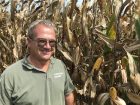Quinoa (pronounced Keenwa) is an old, native South American plant that has become very popular in the U.S. over the past several years. Traditionally known as the “mother grain” and sacred to the Inca and Aztec cultures, Quinoa, has primarily been imported from the Aymara and Quechua Indians who live in mountainous regions of Ecuador, Peru, Bolivia, southern Colombia, northern Argentina and Chile. Since the 1970’s there have been some interesting stories and attempts to bring Quinoa to the U.S. commercially, but still it is not grown widespread in North America.
Quinoa can be found in most grocery and natural food stores these days. The prices tend to be high though. In places like Bolivia, where quinoa has been a staple food for 1000’s of years, the global demand for Quinoa has also caused prices to skyrocket. Quinoa has become too expensive to buy at the markets there, where white bread and rice are now a cheaper option.
Whereas most “grains” come from grasses, Quinoa is a broadleaf non-legume called a chenopod, related to species like beets and spinach. Quinoa is also closely related to lambs quarters and can easily cross with it. Quinoa has far superior nutrition than almost any other vegetable or cereal. According to the Food and Agriculture Organization (FAO) of the United Nations, quinoa is considered a perfect food, comparable in nutrition to dried whole milk. Compared to wheat, barley or corn, quinoa has a lower sodium content and is higher in calcium, phosphorus, magnesium, potassium, iron, copper, manganese, and zinc (source). The leaves of quinoa are also edible and can be treated as you would spinach or amaranth leaves.
In South America quinoa is generally grown in marginal areas that are not fit for other types of crops. Wherever it’s grown quinoa can tolerate drought and low soil fertility, acidic or alkaline soil, light frost and even freezing after the seed has set. Cool soil is required for the quick (24 hour-4 day) germination to occur. Seed should be sown in rows and covered with soil 1/4 inch deep. After seedlings have emerged the plants can be spaced around 10-14 inches apart. Plants grow 4-6 feet in height, have interesting foliage, and are ready for harvest in around 100 days.
Seed is ready for harvesting when the leaves drop from the plant and all that is left is the seed heads. For every 9-12 plants you can expect around 1 lb. of seed. The quinoa seed is coated in a bitter substance called saponin. This helps keep the seeds free of insects and deters birds, but must be washed from the seed prior to consumption. When washing, you will know the saponin is gone when the water runs clear, instead of soapy looking. Once the seed is washed, it must be completely dried again for storage, or alternatively just wash what you need as you need it.
So why not try growing some quinoa this year?? Here are some U.S. seed sources offering Quinoa:
http://www.jlhudsonseeds.net/OrganicSeeds.htm
http://sustainableseedco.com/search.php?mode=search&page=1
http://www.wildgardenseed.com/index.php?cPath=50
http://rareseeds.com/catalogsearch/result/?q=+quinoa&searchbox=products&Submit=
As always, check to see what Pick-A-Pepper.com is offering as far as seeds, produce, or other locally grown or produced items! The possibilites are endless!
Photo of Bolivian quinoa field
Similar Stories:
- Health and Environmental Hazards of GMOs: An Annotated Bibliography.
- How To Grow Stevia and Make Your Own Extract
- Soil Blocks for Seed Starting
- Greens To Grow In Hot Weather
- 20 Perennial Crops to Plant Now and Enjoy For A Lifetime.



